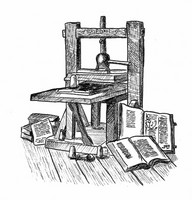The Evolution of Printers and Copiers: From Gutenberg to 3D Printing
Copiers and printers have a fascinating history. Here we briefly explore the story of how these devices have evolved from their beginnings to the cutting-edge technologies they are today.
The Printing Press
The story begins in the 15th century with Johannes Gutenberg’s invention of the printing press around 1440. This monumental creation revolutionized the spread of knowledge by mechanizing the production of books and pamphlets. Gutenberg’s press used movable type, allowing for the mass production of identical copies quickly and efficiently.
Over the centuries, improvements were made to printing tech, including advancement of typesetting, paper handling, and ink setting. However, it wasn’t until the late 19th century that the next significant leap occurred with the invention of the photocopier.
Photocopiers
The photocopier’s origins trace back to 1938 when Chester Carlson invented a dry copying process called electrophotography, which later became known as xerography. The breakthrough came in 1959 when Xerox Corp. introduced the first commercial plain paper photocopier, the Xerox 914. This machine revolutionized office work by allowing workers to make high-quality copies quickly and inexpensively.
The success of the Xerox 914 sparked a wave of innovation in copier technology, leading to improvements in speed, quality, and functionality. By the 1980s, copiers were essential pieces of office equipment.
Dot Matrix to Laser
The first electronic printer, the dot matrix printer, emerged in the 1970s. It used a grid of pins to strike an inked ribbon that produced characters and images by impact. Dot matrix printers were robust and widely used for both personal and business reasons.
The 1980s saw the advent of laser printers, which utilized laser technology and electrostatic principles to produce high-resolution prints at a faster pace than dot matrix printers. Laser printers quickly became the standard for offices due to their superior print quality and speed.
Inkjet Printers and Beyond
In the 1990s, inkjet printers gained popularity for their ability to produce high quality color prints. These printers spray microscopic droplets of ink onto paper that produces vibrant colors and sharp text. Inkjet technology continues to advance today, with modern printers capable of photo-realistic prints and support a wide range of print media.
Today, the printer landscape includes a diverse array of technologies, which includes 3D. Invented in the 1980s but gaining widespread attention in the last decade, 3D printers create three-dimensional objects by depositing layers of material according to a digital model. This technology has revolutionized prototyping, manufacturing, and even healthcare, where it's used to create prosthetics and implants.
The Future of Printing and Copiers
Printers and copiers show no signs of slowing down in their use across the world. Advancements in artificial intelligence, cloud computing, and material science promise to further transform the industry. We can expect printers and copiers to become even more integrated in our everyday lives through digital workflows. They offer smarter, more efficient solutions for communication and manufacturing.
As technology continues to evolve, so too will the capabilities of these indispensable tools, which ensures they remain a vital component of our digitally connected world.
RSI offers a wide variety of multifunctional copiers, desktop copiers and printers and accessories to help you succeed. Check out our selection today.
Recent Posts
-
The Benefits of a Wide Format Printer
Wide format, or large format, printers were mostly used by a niche audience for many years. Busines …Jul 15th 2024 -
How to Calculate Printer & Copier Cost Per Page
The cost of printing and/or copying is crucial for managing business expenses. Whether you're a smal …Jul 10th 2024 -
The Sustainability Advantage: Buying Copiers Wholesale
Sustainability isn't just a buzzword -- it's a critical aspect of responsible corporate practice. Bu …Jul 8th 2024





